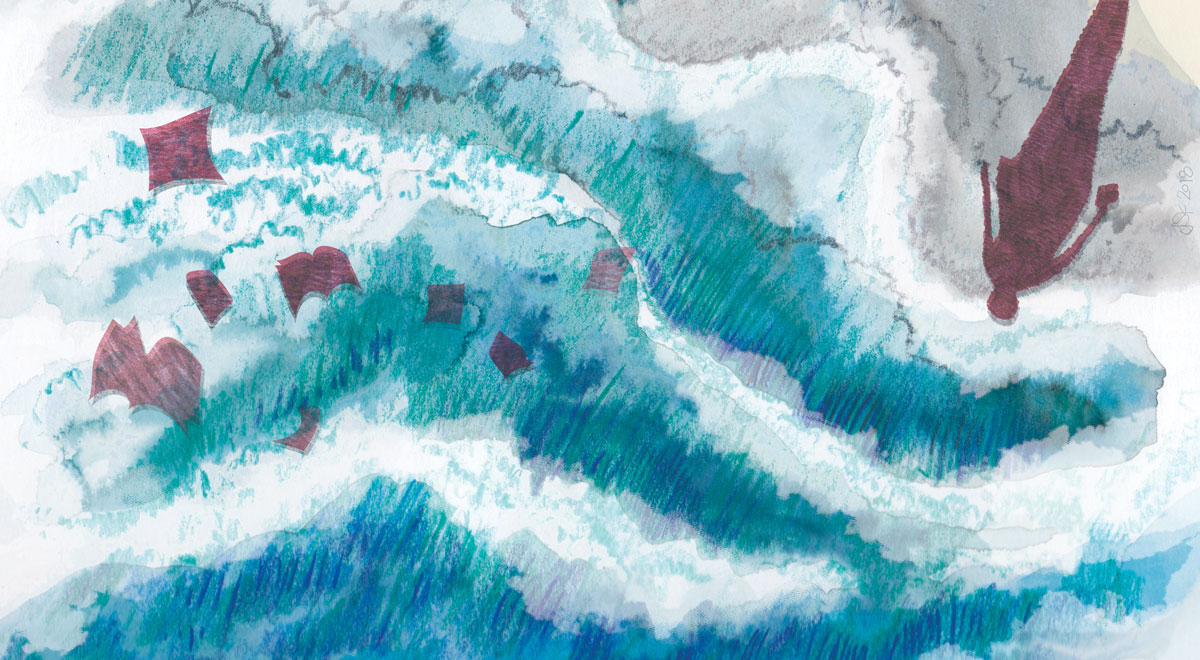Breadcrumb #445
REY ARMENTEROS
When I was reading Tolkien's The Lord of the Rings, I used mental approximations for oaks and elms every time I ran up against them. I would find "oak" in a sentence, and all I knew was tree. My image for oak then was nothing more than a general tree.
Outside of pine trees and palms, I had little notion of what the different types of trees looked like. I was not aware of their seasonal changes — being from Miami, I only knew one season. Tolkien's rich environment and whatever implied meaning he was driving at was lost on a reader that could never differentiate a maple from an oak.
And yet I love trees! I take notice of them every time they call my attention by a shift of sunlight or by clusters of diverse textures in the distance. I appreciate the grace of branches, and I try to memorize the exact shapes of leaves. I take whatever haphazard details I can recollect back into my studio, and I try to paint the details that remain with me.
But was a branch dark gray or brown? Was there an order of connections that the branch had as it climbed up into the canopy? I could visualize the image, but not every correct element would make it intact. Since I draw and paint from memory, understanding what you had seen earlier provides a greater advantage than merely memorizing random details.
I went to the library one day and found a few books on botany. I took them home to go about studying the categorization of plants with seriousness. I was finally going to acquire some understanding about trees.
However, I immediately ran into walls of scientific jargon. A dry text was what I encountered. Keen specificity were the barbs I had to negotiate. The first book didn't even have a warm introduction to spur me on. Before getting into the good stuff, the general groupings of species and other foundational information was too convoluted for the novice, and forty pages in, I was convinced there was not going to be any "good stuff."
I had given up, but I had not forgotten. In another part of the country, at another library, some years later, quite by accident, I found a how-to book on painting trees. I was flipping through it, convinced it was just another book on artistic technique when I slowly realized what the author was in fact doing. He was classifying the basic types of trees, grouping each one in two-page spreads, explaining through the point of view of a watercolorist what differences to look for in each type.
Enraptured, I took it home, read each spread carefully, took notes, and committed them to memory. His descriptions of what to look for provided me with building blocks. The structures of things were being decoded for me, and I was dreaming up possibilities for how to use them with my own painting techniques. I was taking my work from memory and infusing it with a system.
However, I soon took this basic knowledge and found myself asking questions, wondering why paint trees when we have real trees all over creation? Here's a charming little painting by the symbolist Gustav Klimt I find in an art history book, and the trees look so convincing. But do I want to look at Klimt's lesser known landscapes or see the actual landscape? We assume this is what the trees looked like under such lighting and other conditions. Klimt's simple, clear landscapes are beautiful, but I feel real trees are so much more than the ones that are raised in the mind's fancy with his maneuvers in oil paint.
On the other hand, I could be wrong since I have never seen the actual paintings but only photographic reproductions of them. However, regardless of which tree tickles the mind in a more direct manner, Klimt does provide ideas by the way he composes them, the manner in which he paints them, and the colors which he chooses. And these ideas, if still present to someone who had discovered them in his paintings, would bounce off the actual landscape when the time comes to look at an actual tree. And just like how the painted tree can bring up the visual characteristics of a real tree in your head, the real tree may have a tendency of invoking the tree that was made with nothing but paint marks. I know because I have seen such trees once under the same lighting conditions and immediately thought of Klimt.
“And these ideas, if still present to someone who had discovered them in his paintings, would bounce off the actual landscape when the time comes to look at an actual tree.”
It is reassuring, but after asking why paint trees, I take a broader view. Why paint anything for that matter? An open doorway within open doorways, a face in the dark?
Here is the glow that rises out of the bedroom at this late hour in the afternoon, and the orange nature of the light is noticed when I step out of the room and find that the orange room frames the blue bathroom like a sky blue rectangle cut into the wall.
I painted this thing a couple of years ago when I was transfixed by the warm and cool tones folding into these rooms. I was recreating the moment from memory. The bedroom is not orange, and the bathroom is not blue; the walls that are merely white were caught in a sunset that turned them into something else. I enjoyed the very idea of this transformation. I painted it with the orange and blue as close as I could remember.
But then, an interesting thing happened. After it was done, I could not help looking at this painting of mine about ephemeral light without acknowledging its quiet purpose lifted and turned into a silent declaration — in my mind, with time, the rectangle of the door in my painting became a long tombstone, and the feeling was now solemn.
And these unexpected ominous overtones brought up a singular beauty that I wasn't going to get from the real situation of the room in particular lighting conditions. I would like to think that my process of roaming through the depths of memory to resurrect this moment provided the bricks that would turn my quiet experience with the room into something different, something the paint discovered, as if in this room that was a part of my home, the paint found an apparition.
Breadcrumb #385
ROBIN KROSINSKY
I don’t know when the room stopped being blue. I think it happened while I was in high school, when the room wasn’t being used as much. Mom thought it needed a facelift. The blue paint was replaced with floral wallpaper—hydrangeas with little green leaves. But we never stopped calling it the blue room.
We called it the blue room because it wasn’t quite a den, it wasn’t the living room, and it never fully became a storage space. “Just put it in the blue room,” became a well-known phrase in our family. When I was in elementary school, my parents filled a wardrobe in the room with art supplies and I used to paint watercolor oceans while sitting on the sun-warmed wooden floor.
Mom and I once spent an afternoon rearranging the furniture in the blue room. We cleaned out the shelves filled with everything from second grade spelling homework to forgotten about stuffed animals. At the time, we thought that if we cleaned up the room, which had become the family dumping ground for anything that didn’t fit in any other room in the house, we could make better use of it; it could be a place to relax, watch television, use the exercise bike gathering dust in the corner.
On the morning of the move I walked from room to room, saying goodbye to each space. I thanked our terracotta-colored kitchen where I learned to cook. I told the blue room I was sorry I stopped hanging out there after middle school ended. I opened every empty drawer in the bathroom I shared with my older brother and wished they were still filled with bottles of roll-on glitter and cracked palates of pale foundation.
“I told the blue room I was sorry I stopped hanging out there after middle school ended.”
I saved my bedroom for last. I stood in the center of the rectangular room, my feet covering a stain in the cream carpet. My mom tried to convince me against the pale color, knowing how stained it would become, but I insisted. Cream carpet and butter yellow walls and a twenty-year-old girl trying to say goodbye to a room without feeling like she was saying goodbye to the life lived within it.
I wanted so badly to sit down. But I knew if I did, I wouldn’t be able to pry my body from the floor to walk down the stairs and out the front door (but we never use the front door) and into the packed car where my dad was waiting, impatiently, to drive me away from our home for the last time and drop me back at school where I was living for the summer because I wanted to, but also because the rental house wasn’t ready yet so my family was technically homeless.
I stood in the center of the room and couldn’t think of anything to say besides goodbye and I’ll miss you, and when I said “I’ll miss you,” I started crying despite how hard I had been trying to keep the sadness in the back of my throat where it was aching to come out.
The car was packed with everything we couldn’t fit into boxes, including our cat, who was perhaps the most traumatized by the move. My dad thought it was a good idea to let him out of his crate during the drive, and he immediately crawled under the front passenger seat and got stuck between two metal bars. He moaned deeply and quietly until we were able to pull over and get him back into his crate, where he continued to cry out in misery for the rest of the drive.
“He just needs time, he’ll adjust.” Dad said without taking his eyes from the road. I mumbled my response, no longer able to control the burning-hot tears blurring my vision and streaking my face with salt.


